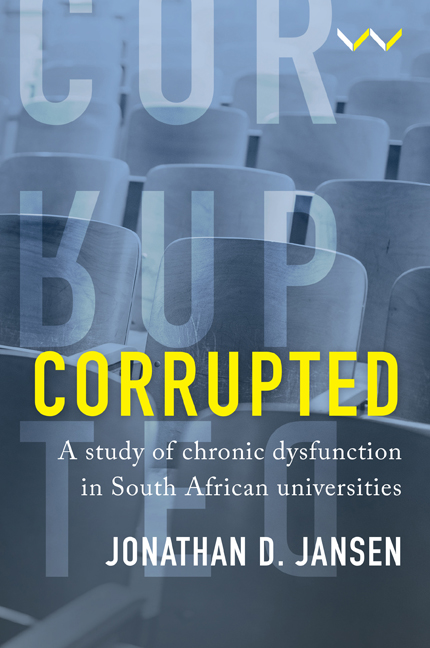Book contents
- Frontmatter
- Contents
- Acknowledgements
- Acronyms and Abbreviations
- Map: South African Universities
- Chapter 1 A Study of Chronic Dysfunction in Universities
- Chapter 2 Historical Roots of Dysfunction: Shaping the South African University
- Chapter 3 Dysfunctionality in Universities: A Political Economy Perspective
- Chapter 4 A Personal Journey Through the Political Economy of Universities
- Chapter 5 Casting Long Shadows: How History Shapes the Politics of Universities In South Africa
- Chapter 6 The University as a Concentrated and Exploitable Resource
- Chapter 7 The University as a Criminal Enterprise
- Chapter 8 The Micropolitics of Corruption in Universities
- Chapter 9 The Twin Roots of Chronic Dysfunctionality in Universities
- Chapter 10 Rethinking and Rebuilding Dysfunctional South African Universities
- Appendices
- Notes
- References
- Index
Chapter 2 - Historical Roots of Dysfunction: Shaping the South African University
Published online by Cambridge University Press: 29 November 2023
- Frontmatter
- Contents
- Acknowledgements
- Acronyms and Abbreviations
- Map: South African Universities
- Chapter 1 A Study of Chronic Dysfunction in Universities
- Chapter 2 Historical Roots of Dysfunction: Shaping the South African University
- Chapter 3 Dysfunctionality in Universities: A Political Economy Perspective
- Chapter 4 A Personal Journey Through the Political Economy of Universities
- Chapter 5 Casting Long Shadows: How History Shapes the Politics of Universities In South Africa
- Chapter 6 The University as a Concentrated and Exploitable Resource
- Chapter 7 The University as a Criminal Enterprise
- Chapter 8 The Micropolitics of Corruption in Universities
- Chapter 9 The Twin Roots of Chronic Dysfunctionality in Universities
- Chapter 10 Rethinking and Rebuilding Dysfunctional South African Universities
- Appendices
- Notes
- References
- Index
Summary
The first South African university was the University of the Cape of Good Hope, which was established by an Act of Parliament of the Cape Colony in 1873. It was not a teaching university, but set standards and examinations for what were known in those early years as ‘university colleges’. It was renamed the University of South Africa in 1916, relocated from the Cape to Pretoria in 1918, and only started to offer ‘postal tuition’ about three decades later, in 1946.
The South African College, established in 1829, was a high school for boys, but it contained within it a small tertiary education component, which developed into a fully fledged institution, the University of Cape Town (UCT), in 1918. The Victoria College, so named in 1887, also developed out of smaller constituent parts, including an arts department, and became the University of Stellenbosch (now Stellenbosch University [SU]) in 1918. It was not, in fact, uncommon in those times for ordinary schools to have ‘university college departments’ as part of their facilities.
Apart from the two former colleges that became independent teaching universities (UCT and SU), the rest were organised as a ‘federation of colleges’ under the aegis of the University of South Africa (Unisa). These included Natal University College in Pietermaritzburg, founded in 1910; Grey University College in Bloemfontein, founded in 1906; Transvaal University College in Pretoria, founded in 1910; Rhodes University College in Grahamstown, founded in 1904; the School of Mines and Technology in Johannesburg, founded in 1910; and the Potchefstroom University College for Christian Higher Education, founded in 1919.
These affiliate colleges of Unisa would in time gain independent university status – as the University of Natal in 1949; the University of the Orange Free State in 1950; the University of Pretoria in 1930; Rhodes University in 1951; the University of the Witwatersrand in 1922; and Potchefstroom University for Christian Higher Education in 1951. All of these were racially segregated white universities.
The first black institution of higher learning was the South African Native College, founded in 1916, which became the University College of Fort Hare in 1951, and the University of Fort Hare in 1970. Unlike the white colleges, this ‘Native College’ was not a constituent college of Unisa, but it did prepare its students for Unisa's external examinations.
- Type
- Chapter
- Information
- CorruptedA Study of Chronic Dysfunction in South African Universities, pp. 19 - 28Publisher: Wits University PressPrint publication year: 2023



